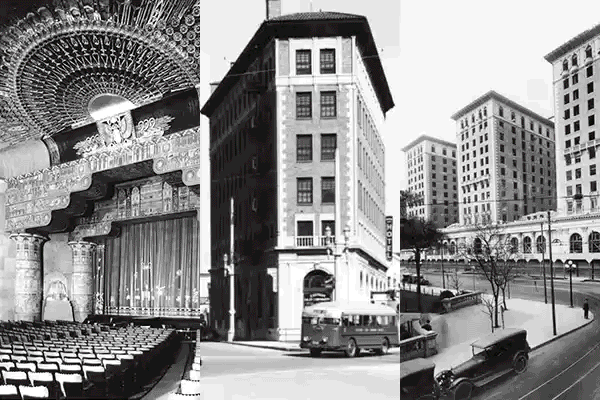Filmmaking Moves West, Creating a New Lifestyle
- Share via
The wedding of Mary Pickford and Douglas Fairbanks created Hollywood’s first royal couple.
They entertained celebrities, including actual royalty from around the world, at their famous Beverly Hills residence, Pickfair, which they transformed from a hunting lodge into a handsome residence with elegant, sunny interiors. It would be home to America’s Sweetheart until her death there in 1979--and more than 40 years after her divorce from Fairbanks, the silent screen’s most dashing swashbuckler.
By 1920 the industry had shifted its center of production from the East Coast to the West, which afforded freer, cheaper working conditions in a mild climate.
The feature-length film was firmly established; movie palaces were beginning to sprout up in even the country’s smallest cities. And that year Pickford and Fairbanks joined forces with Charlie Chaplin and D.W. Griffith to form United Artists.
The Pickford-Fairbanks marriage--covered by the press as though it were a major event of state--symbolized how far the motion picture industry had come in a very short time and also portended just how important stars and their movies would become in the lives of Americans, and even more to Southern California. The couple established Hollywood high society, a social register not of old blood but of new fame, along with the glittering party life that society would enjoy.
The newlyweds, both having been married previously, were testing their fans’ acceptance of divorce and remarriage, no small issue at the time.
Thanks to the movies, Pickford, Fairbanks, Chaplin and other early stars became famous as virtually no other human beings had been in the history of the world. (When Chaplin told his second wife, Lita Grey, that he was more famous than Jesus, she thought him blasphemous but also thought he might be right.)
In the silent era, film spoke a truly universal language, with English intertitles easily substituted with wording in other languages. Indeed, you didn’t even need to be able to read to respond to the humor and pathos of Chaplin’s Little Tramp, be moved by Pickford’s plucky young heroines or Fairbanks’ smiling athletic derring-do.
*
And as Hollywood movies enchanted a world audience, they simultaneously transformed Southern California’s economy and lifestyle. They changed the lives of my own family. Relatives who had helped found Hollywood and name its streets were soon replacing their citrus groves along Hollywood Boulevard with office buildings and lending Sid Grauman $10,000 toward the construction of the Egyptian Theater, the boulevard’s first movie palace.
When Cecil B. DeMille filmed the interiors of “The Squaw Man” in 1913 in a barn at Selma and Vine, Hollywood was established as the focal point of Los Angeles’ burgeoning filmmaking efforts. Hollywood landladies were quickly posting signs, “No Actors Welcome.” But in very short order, some of those same actors became stars, building estates in Hollywood and later following Pickford and Fairbanks to Beverly Hills. The growing film colony launched a glamorous night life, eventually centered primarily on the Sunset Strip.
It also afforded a wide range of job opportunities--one of my cousins became Pickford’s business manager--and encouraged the growth of countless support industries. By the time World War II broke out, Hollywood offered a refuge for filmmakers fleeing Hitler; agent Paul Kohner was a leader of the effort to bring European stars, writers and directors to Hollywood and to find them work and shelter. The movies would suffer in the 1950s with the advent of television, but would rebound again to new box office highs today.
The milestone of the Pickford-Fairbanks marriage was followed 15 years later by their divorce; Fairbanks would die in 1939. Pickford married actor and producer Charles “Buddy” Rogers, and continued to live out her life at Pickfair.
For Pickford’s wake, Rogers and Pickford’s stepson Douglas Fairbanks Jr. hosted a small but unforgettable gathering at the estate. The dining room table was encircled by small round tables covered with pink tablecloths. An elderly man stood up to say that it was he who had given Pickford her famous bob, sacrificing at last her trademark little-girl sausage curls.
Referring to Pickford’s endless good works and contributions to the industry, Lillian Gish, then 85, remarked that “the world will never know all that she got done around that dining room table.”
The original main section of Pickfair would soon be demolished, and Gish would be gone herself. Rogers died last April. And Old Hollywood is no longer.
More to Read
The biggest entertainment stories
Get our big stories about Hollywood, film, television, music, arts, culture and more right in your inbox as soon as they publish.
You may occasionally receive promotional content from the Los Angeles Times.










